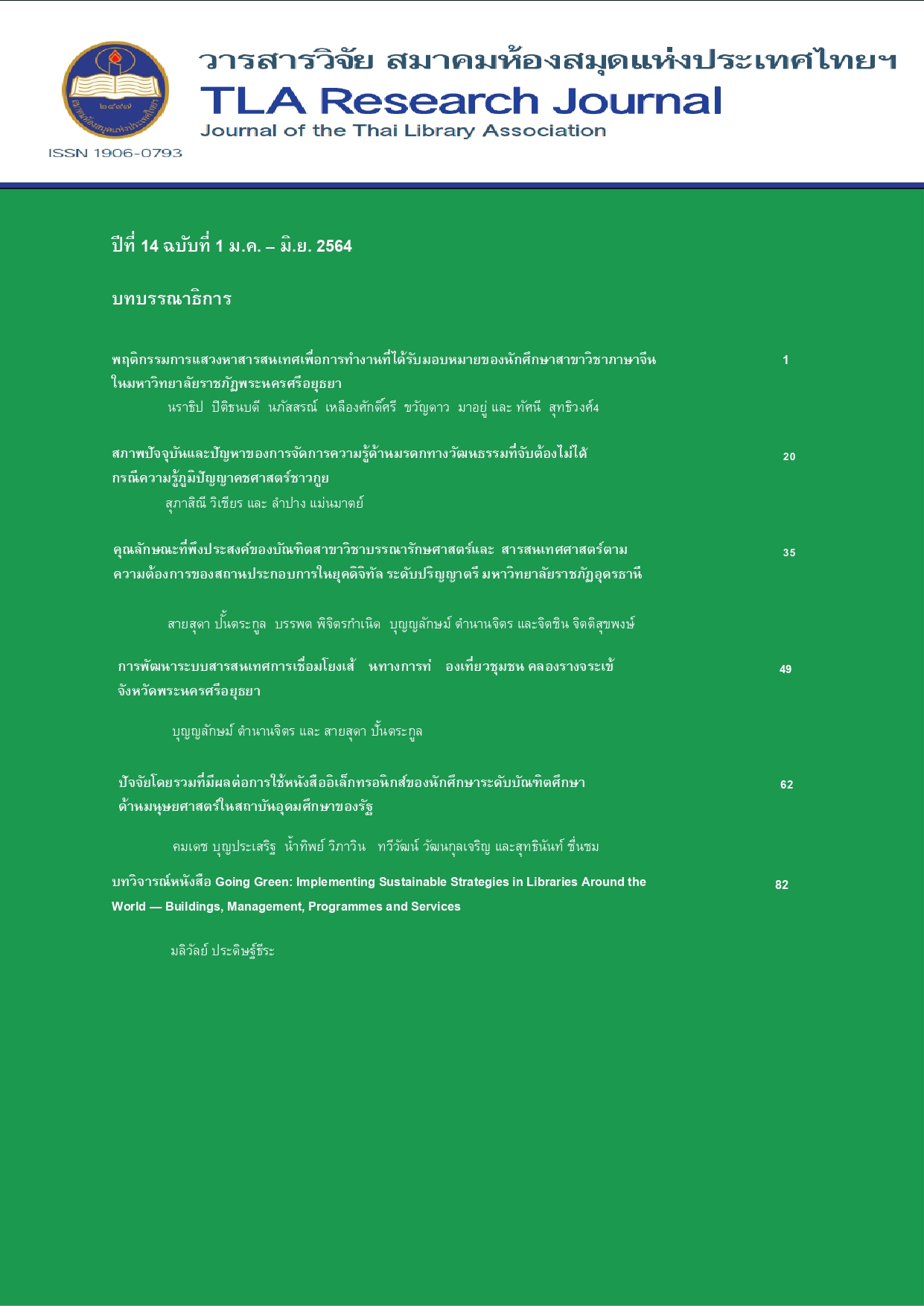Current situation and problems of intangible cultural heritage knowledge management, a case of folk Gajasastra inherited wisdom of the Kui
Main Article Content
Abstract
This research aimed at studying current situation and problems of intangible cultural heritage knowledge management a case of folk Gajasastra inherited wisdom of the Kui. Qualitative research method was applied in this research in the form of document analysis. The data were collected by interviewing with executives or the persons in charge and staff who are involved in knowledge management of a case of folk Gajasastra inherited wisdom of the Kui in 5 organizations. For a total of 10 participants, two participants from each organization were selected divided into one executive or person in charge and one staff. The research instruments were a semi-structured interview and the data sheet of a case of folk Gajasastra inherited wisdom of the Kui management knowledge. The data were analyzed by grouping, summarizing and interpreting in the form of qualitative description. The results revealed that a case of folk Gajasastra inherited wisdom of the Kui knowledge management consisted of collecting, storing and accessing the a case of folk Gajasastra inherited wisdom of the Kui knowledge management library and the museum of the management of cultural objects of the Kui people. The way each process was performed differed depending on the characteristics of the resource because there was no standardized management system. Therefore, it was not possible to relate the knowledge recorded in different media formats to one another.
Article Details
บทความทุกเรื่องที่ลงตีพิมพ์จะได้รับการตรวจอ่านโดยผู้ทรงคุณวุฒิ ความคิดเห็นและบทความที่ปรากฏในวารสารนี้ เป็นของผู้เขียนซึ่งมิใช่เป็นความคิดเห็นของคณะผู้จัดทำ และมิใช่ความรับผิดชอบของสมาคมห้องสมุดแห่งประเทศไทยฯ การนำบทความในวารสารนี้ไปตีพิมพ์ซ้ำต้องได้รับอนุญาตจากคณะผู้จัดทำ
All articles submitted for publication will be reviewed by the academic reviewers. The editorial board and TLA claim no responsibility for the content or opinions expressed by the authors of individual articles or columns in this journal. Reprinting of any articles in this journal must be permitted by the editorial board.
References
Association of Southeast Asia Nations. (2009). Roadmap for an ASEAN community 2009 – 2015. Jakarta: ASEAN Secretariat. Retrieved from https://www.asean.org/storage/images/ASEAN_RTK_2014/2_Roadmap_for_ASEAN_Community_20092015.pdf
Australian Bureau of Statistics. (2014). Australian Culture and Leisure Classifications, 2014 (3rd ed.). Retrieved from https://www.abs.gov.au/ausstats/abs@.nsf/mf/4902.0
Chen, Y.N., Chen, S.J., Sum, H.C., & Lin, S.C. (2003). Functional requirements of metadata
system: from user needs perspective: from user needs perspective, in International Conference on Dublin Core and Metadata Applications (pp. 91-98). Retrieved from https://dcpapers.dublincore.org/pubs/article/view/737
Greece. (2002). Law 3028/2002 on the Protection of antiquities and cultural heritage in general. Retrieved from https://www.ecolex.org/details/legislation/law-no-30282002- on-the-protection-of-antiquities-and-cultural-heritage-in-general-lex-faoc105346/
Intangible Cultural Heritage Office. (2019). Hong Kong intangible cultural heritage database. Retrieved from https://mmis.hkpl.gov.hk/ich?from_menu=Y&dummy
Japan. (2007). Law for the protection of cultural property. Retrieved from
https://en.unesco.org/sites/default/files/japan_law_protectionproperty_entno.pdf
Joudrey, D.N., Taylor, A.G. and Wisser, K.M. (2018). The Organization of Information.
(4th ed.). Santa Barbara, California: Libraries Unlimited.
Leisure and Cultural Services Department, The Government of the Hong Kong Special Administrative Region. (2019). Mission, vision and values. Retrieved from
https://www.lcsd.gov.hk/en/aboutlcsd/mission.html
Lower Southeastern Culture Center, Buriram. (2019). คู่มือนำชมศูนย์วัฒนธรรมอีสานใต้ จังหวัดบุรีรัมย์ [Guide for Lower Southeastern Culture Center]. Buriram: Buriram Rajabhat University. [In Thai]
Marquardt, M. J. (2002). Building the learning organization: Mastering the 5 elements for corporate
learning. (2nd ed.). Palo Alto, C.A.: Davies-Black.
Ministry of Culture, Department of Cultural Promotion, Thailand. (2019). คชศาสตร์ชาวกูย. [Folk Gajasastra inherited wisdom of the Kui in Surin province]. Retrieved from http://ich.culture.go.th/index.php/th/ich/knowledge-about-nature-universe/269-nature-universe/430--m-s [In Thai]
Ministry of Tourism and Sports, Thailand. (2019). Domestic tourism statistics (Northeastern). Retrieved from https://www.mots.go.th/News-link.php?nid=13039 [In Thai]
People's Republic of China. (2011). Order of the president of People's Republic of China No 42: Law of the People's Republic of China on intangible cultural heritage. Retrieved from http://www.wipo.int/wipolex/en/text.jsp?file_id=336577
Princess Maha Chakri Sirindhorn Anthropology Centre (Public Organization). (2017). Guidelines for managing digital archives Project to study and develop, guidelines for managing digital archives. Bangkok: SAC. [In Thai]
Romanion Government. (2007). ORDINANCE no.19 of January 31st 2007 on the immaterial cultural heritage protection. Retrieved from https://ru.unesco.org/sites/default/files/rom_ord_19_engtof.pdf
Surin National Museum. (2019). พิพิธภัณฑสถานแห่งชาติ. [Surin National Museum]. Retrieved from http://www.finearts.go.th/surinmuseum/ [In Thai]
The Burke Museum. (2019). Collections databases. Retrieved from https://www.burkemuseum.org/collections-and-research/collections-databases
The Seattle Public Library. (2019). Seattle culture & local history. Retrieved from https://www.spl.org/online-resources/seattle-culture-and-local-history
UNESCO. (2003). Convention for the safeguarding of the intangible cultural heritage. Retrieved from https://ich.unesco.org/doc/src/15164-EN.pdf
UNESCO library. (2019). UNESDOC UNESCO digital library. Retrieved from https://unesdoc.unesco.org/library
United Nations. (2010). Creative economy report 2010. Retrieved from http://unctad.org/en/Docs/ditctab20103_en.pdf
United Nations. (2005). The 2005 convention on the protection and promotion of the diversity of cultural expressions. Retrieved from https://en.unesco.org/creativity/sites/creativity/files/passeport-convention2005-web2.pdf
Vongthip, V. (2014). The guiding principle to the protection of traditional knowledge in Thailand: a comparative study between Thailand and India. Suthiparithat Journal, 28(87), 323-344. [In Thai]
WIPO library. (2019). WIPO library. Retrieved from https://www.wipo.int/library/en/
WIPO. (2016). Intellectual property and traditional knowledge (WIPO Publication No. 920(E)). Retrieved from http://www.wipo.int/edocs/pubdocs/en/tk/920/wipo_pub_920.pdf
WIPO. (2013). WIPO draft guidelines on assessing the economic, social and cultural impact of copyright on the creative economy. Retrieved from http://www.wipo.int/export/sites/www/copyright/en/performance/pdf/escia.pdf


